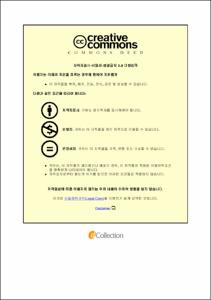수영강의 수질변화와 강우유출의 영향
- Abstract
- The Suyeong River is the river that separates the eastern part of Busan. Upstream water protection areas, sewage is flowing effect middle and downstream of the Corporation is brackish water zone due to the influx of seawater. Recently, it was realized that a significant portion of pollution from urban areas origininated from non-point sources such as construction, washoff from impervious surfaces, and sewage input from unsewered areas and combined sewer overflows. Especially, urban stormwater runoff is the one of the most extensive cause of the deterioration of the water quality in streams located in urban area.
Recently, it has been realized that BOD and COD as an index of organic matter have some limitation on the management of the Suyeong River water quality. Aquatic organic matter present mostly dissolved organic matter(DOM) in all natural waters. Aesthetic problems and hazardous materials such as amounts of trace elements may be attached to organic material. Also DOMs have been recognized disinfection by-products (DBPs) precursors during the chlorination process, many ways may affect the unit operations in water treatment.
BOD and COD are currently used for water quality indicates, but BOD test takes too much time to provide timely information to the operator for control purposes. In addition COD test is relatively resistant to some organic matter and may give a falsely low COD. Therefore, BOD and COD were inappropriate indices as effective water management. TOC tend to distinct organic matter concentration and low error range than BOD and COD.
Accordingly, the properties of organic matters investigated in the Suyeong River. This study analyzed monthly tendency of DOM and characteristics changes of dissolved organic matter presented by flowing in non-point source through rainfall. The hydrophobic DOM of the upstream are generally higher than the downstream. The hydrophilic DOM of rainfall is higher than non-rainfall. Also, BDOC is slightly increased. Consequently, the hydrophilic component is a major organic matter flowing into the watershed at rainfall.
The water quality is going about lower being deteriorated with increase of the various pollution and increase of the non-point source. Specially, the effect of the non-point source is the tendency which increases day after day with deepening of land use and control efficient increase of the point source. Therefor, it will be need that the accurate waste load of non-point source and increase of treatment of non-point source is demanded. But, the control of non-point source is very difficult because they are charged by spatial distribution, soil type, land use, rainfall, topological characteristic.
Water quality variations were investigated at 2 locations of Suyeong River during a period of 10 rainfall events. Concentration difference of non-point pollution source appeared to be big by precedent number of days of no rainfall. In addition, Event mean Concentration (EMCs) that well represents runoff characteristics of storm water during rainfall, was calculated, and runoff pollutants loading was also examined. We analyzed probability distribution of EMCs of BOD, COD, TOC, TN, TP, and TSS and compared the mean values of observed EMC and the median values of estimated EMCs through probability distribution. During the storm events, measured EMC ranges of BOD, COD, TOC, TSS, TN, and TP in Suyeong River were 0.16∼13.9 mg/L, 1.3∼14.0 mg/L, 0.15∼3.8 mg/L, 14.3∼60.7 mg/L, 3.1∼30.2 mg/L, 0.11∼0.57 mg/L respectively.
The aims of this study are the characterization of discharge from non-point source, the analysis of the pollutant loads and an establishment of a management plan for non-point source of Suyeong River.
- Issued Date
- 2016
- Awarded Date
- 2016. 8
- Type
- Dissertation
- Publisher
- 부경대학교 대학원
- Affiliation
- 부경대학교 대학원
- Department
- 대학원 환경공학과
- Advisor
- 강임석
- Table Of Contents
- 제 1 장 서론 1
제 2 장 문헌연구 3
2.1 하천의 특성 3
2.1.1 소하천의 특성 4
2.1.2 기수역 5
2.2 비점오염원의 정의 및 특성 6
2.2.1 오염원의 정의 6
2.2.2 국내·외 연구현황 7
2.2.3 비점오염원의 구분 10
2.2.4 비점오염원 유출특성 11
2.2.5 유량가중평균농도 (EMC) 15
2.3 DOM (Dissolved Organic matters)의 분류와 특성 17
2.3.1 DOM의 분류 17
2.3.2 DOM의 구조적 특성 20
2.3.3 DOM의 생분해도에 따른 분류 24
2.3.4 수계의 난분해성 유기물질의 특성 26
2.3.5 유기오염물질의 관리지표 29
제 3 장 재료 및 방법 31
3.1 연구 대상지역 31
3.2 실험 재료 32
3.2.1 수질 조사지점 32
3.2.2 조사방법 33
3.3 분석 방법 33
3.3.1 수질 분석 33
3.3.2 DOM 성상 분석 37
3.3.3 유기물 생분해 특성 분석 38
3.3.4 유량측정 방법 41
제 4 장 결과 및 고찰 42
4.1 수영강의 수질 특성 분석 42
4.1.1 수영강의 연평균 수질 특성 42
4.1.2 수영강의 계절적 수질 특성 50
4.1.3 수영강의 유기오염물질 농도변화 57
4.1.4 수영강 하류의 조석차이에 의한 수질 특성 59
4.2 강우에 따른 수질특성 변화 63
4.2.1 강우현황 및 강우 사상 63
4.2.2 강우에 의한 수영강 수계의 수질 특성 66
4.2.3 강우 유형별 수질 특성 111
4.2.4 강우에 의한 유출부하량 특성 114
4.2.5 유량가중평균농도 (EMCs) 통계 분석 120
4.3 수영강의 유기물 특성 변화 124
4.3.1 수영강의 유기물 지표간의 특성 124
4.3.2 수영강의 유기물 성상 분류 126
4.3.3 수영강의 생분해에 따른 유기물 특성 변화 128
4.3.4 유기물 기원에 따른 상관관계 130
4.3.5 강우에 의한 유기물 성상변화 134
4.3.6 강우에 의한 유기물의 생분해성분석 136
4.4 수영강의 수질지표 상관관계 138
4.4.1 수영강의 강우 전·후 수질의 주성분 분석 138
4.4.2 수영강의 유기물 지표간 상관성 분석 143
4.4.3 수영강의 유기물 지표간 관계식 설정 148
제 5 장 결론 153
참 고 문 헌 157
Appendix 174
- Degree
- Doctor
- Files in This Item:
-
-
Download
 수영강의 수질변화와 강우유출의 영향.pdf
기타 데이터 / 57.18 MB / Adobe PDF
수영강의 수질변화와 강우유출의 영향.pdf
기타 데이터 / 57.18 MB / Adobe PDF
-
Items in Repository are protected by copyright, with all rights reserved, unless otherwise indicated.